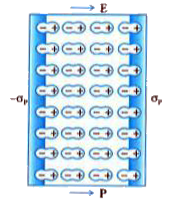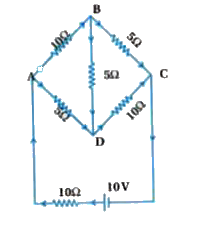How does the polarised cliclectric morufy the original external field inside it ? Solution in Gujrati
When polar or non-polar molecules placed in an external electric field a dielectric develops a net dipole moment.
The dipole moment per unit volume is called polarisation and is denoted by →P .
For linear isotropic dielectrics ,
→P∝→E
∴→P=χe is a constant characteristic of the dielectric and is known as the electric susceptibility of the dielectric medium.

Consider a rectangular dielectric slab placed in a uniform external field →E0 parallel to two of its faces as shown in figure.
Titis field causes a uniform polarlzation →P of the dielectric .
Every volume element ΔV of the slab has a dipole moment →PΔ V in the direction of the field .
The volume element AV is macroscopically small but contains a very large number of molecular dipoles. It has no net charge (Total charge on dipole is zero) but has net dipole moment.
Because, the posldve charge of one dipole sits close to the negative charge of the adjacent dipole in rectangular slab.
However at the surfaces of the dielectric normal to the electric field there is a net charge density.
In figure, the unbalanced charges are the induced charges due to the external field.
Thus the polarized dielectric is equivalent to two charged surfaces with induced surface charge densities σ and σp .
The field produced by these surface charges opposes the external field hence the total electric field E0 in the dielectric is reduced.
The surface charge density ±σp arises from bound charges but not by free charges in the dielectric.
Topper's Solved these Questions
- BOOK - KUMAR PRAKASHANCHAPTER - ELECTROSTATIC POTENTIAL AND CAPACITANCEEXERCISE - ( Section -A) Try Yourself50videos
ELECTROSTATIC POTENTIAL AND CAPACITANCE
- BOOK - KUMAR PRAKASHANCHAPTER - ELECTROSTATIC POTENTIAL AND CAPACITANCEEXERCISE - Section B Numericals16videos
ELECTROSTATIC POTENTIAL AND CAPACITANCE
- BOOK - KUMAR PRAKASHANCHAPTER - ELECTROMAGNETIC WAVESEXERCISE - BOARD.S QUESTION PAPER MARCH - 2020 (PART - B) SECTION - C5videos
ELECTROMAGNETIC WAVES
- BOOK - KUMAR PRAKASHANCHAPTER - MAGNETISM AND MATTEREXERCISE - SECTION D Multiple Choice Questions (MCQs) (MCQs asked in Competitive Exams) MCQs asked in Board Exam and GUJCET7videos
MAGNETISM AND MATTER
Similar Questions
What are conservative force , non - conservative force , conservative field and non - conservative field ?
02:31View SolutionCalculate the potential at a point P due to a charge of 4×10−7 C located 9 cm away.
01:12View SolutionDetermine the current in each branch of the given network.
 03:17View Solution
03:17View SolutionAt a place on earth the vertical component of earth's magnetic field is √3 times its horizontal component. The angle of dip at this place is …...
02:59View SolutionA point charge q is placed at the origin . How does the electric field due to the charge very with distance r from the origin ?
03:20View SolutionWhy does the electric field inside a dielectric decrease when it is placed in an external field ?
03:20View Solutionलौहचुम्बकीय पदार्थ में चुम्बकन किस प्रकार उत्पन्न होता है, यदि बाह्य क्षेत्र
क्षीण03:20View Solutionलौहचुम्बकीय पदार्थ में चुम्बकन किस प्रकार उत्पन्न होता है, यदि बाह्य क्षेत्र
प्रबल है04:04View SolutionWith the help of neat diagrams, explain how the nonpolar dielectric material is polarised in external electric field of increasing intensity. Define polarisation in dielectrics.
01:12View SolutionWith the help of neat diagrams, explain how the nonpolar dielectric material is polarised in external electric field of increasing intensity. Define polarisation in dielectrics.
View SolutionDue to polarisation the electric field inside a dielectric is
03:13View Solutionजब किसी परावैद्युत को किसी बाह्य विद्युत क्षेत्र में रखा जाता है तो उसके अंदर विद्यत क्षेत्र कम हो जाती है, क्यों?
View SolutionWhy does the electric field inside a dielectric decrease when it is placed in an external field ?
View SolutionTo shield an instrument from external magnetic field, it is placed inside a cabin made of
View SolutionHow will electric field inside a dielectric change on polarisation?
04:48View Solution

